
Liriodendron is a genus of two species of characteristically large trees, deciduous over most of their populations, in the magnolia family (Magnoliaceae).

Hazels are plants of the genus Corylus of deciduous trees and large shrubs native to the temperate Northern Hemisphere. The genus is usually placed in the birch family Betulaceae, though some botanists split the hazels into a separate family Corylaceae. The fruit of the hazel is the hazelnut.

Hamamelidaceae, commonly referred to as the witch-hazel family, is a family of flowering plants in the order Saxifragales. The clade consists of shrubs and small trees positioned within the woody clade of the core Saxifragales. An earlier system, the Cronquist system, recognized Hamamelidaceae in the Hamamelidales order.

Griselinia is a genus of seven species of shrubs and trees, with a highly disjunct distribution native to New Zealand and South America. It is a classic example of the Antarctic flora. It is the sole genus in the family Griseliniaceae. In the past it was often placed in Cornaceae but differs from that in many features.

Fothergilla is a genus of two to four species of flowering plants in the family Hamamelidaceae, native to woodland and swamps of the southeastern United States.
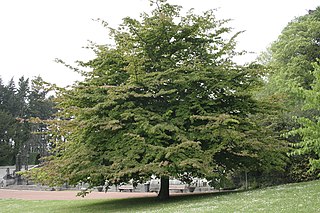
Parrotia persica, the Persian ironwood, is a deciduous tree in the family Hamamelidaceae, closely related to the witch-hazel genus Hamamelis. It is native to Iran's Caspian region and Iranian Azerbaijan. It is endemic in the Alborz mountains, where it is found mainly in Golestan National Park.

Codiaeum variegatum is a species of plant in the genus Codiaeum, which is a member of the family Euphorbiaceae. It was described by Carl Linnaeus in 1753. It is native to Indonesia, Malaysia, Australia, and the western Pacific Ocean islands, growing in open forests and scrub.

Oemleria cerasiformis, a shrub commonly known as osoberry or Indian plum, is the sole species in genus Oemleria.

Howittia is a genus of plant containing the single species, Howittia trilocularis, commonly known as blue howittia, and is endemic to Australia. It is a tall shrub found growing in shaded valleys and on rainforest edges, it has hairy leaves and single, purple flowers.

Hamamelis vernalis, the Ozark witchhazel is a species of flowering plant in the witch-hazel family Hamamelidaceae, native to the Ozark Plateau in central North America, in Missouri, Oklahoma, and Arkansas. It is a large deciduous shrub growing to 4 m (13 ft) tall.
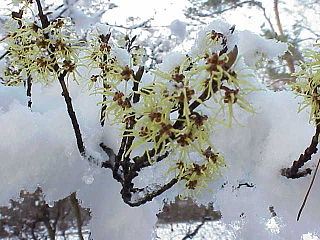
Hamamelis mollis, also known as Chinese witch hazel, is a species of flowering plant in the witch hazel family Hamamelidaceae, native to central and eastern China, in Anhui, Guangxi, Hubei, Hunan, Jiangxi, Sichuan, and Zhejiang.
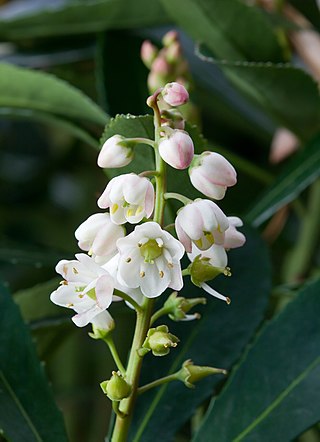
Anopterus glandulosus, commonly known as native laurel or Tasmanian laurel, is a species of shrub or small tree in the family Escalloniaceae. Endemic to south and southwestern Tasmania, A. glandulosus is widespread in the moist understoreys of Tasmanian temperate rainforests and wet sclerophyll forests from sea level to mountainous regions below 1,200 metres (3,937 ft) above sea level.
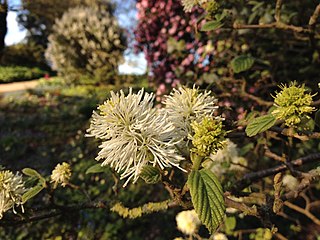
Fothergilla gardenii, also known by the common names witch alder, dwarf fothergilla, American wych hazel, and dwarf witchalder is a deciduous shrub in the Hamamelidaceae family. It is one of two species in the genus Fothergilla.

Exbucklandia is a genus of flowering plants in the family Hamamelidaceae. They are medium to large trees whose natural range is from eastern India through southern China and southward through the Malay Peninsula. In India and China, they are widely cultivated for their impressive foliage and valuable lumber. A few have been grown in the southernmost parts of the United States. To speakers of English, Exbucklandia is generally known as the Pipli tree, from the Bengali name for the species Exbucklandia populnea.

Fothergilla malloryi is an extinct species of flowering plant in the family Hamamelidaceae known from fossil leaves found in the early Eocene Klondike Mountain Formation deposits of northern Washington state. The F. malloryi leaves are the earliest appearance in the fossil record of a member of the witchalder genus Fothergilla, which includes the living species F. gardenii, and F. major, both of which are native to the southeastern United States. The genus also includes three or four other fossil species with two Asian Miocene species, F. viburnifolia from China, F. ryozenensis from Japan along with one Miocene North American species, F. praeolata of Oregon. Fothergilla durhamensis described from Eocene sediments in King County, Washington is considered dubious in placement, and it was transferred to the genus Platimeliphyllum by Huegele et al. (2021).

Corylopsis reedae is an extinct species of flowering plant in the family Hamamelidaceae known from fossil leaves found in the early Eocene Klondike Mountain Formation deposits of northern Washington state. C. readae is one of the oldest occurrences of the winter-hazel genus Corylopsis, which includes between seven and thirty species, all found in Asia. Fossils from two other occurrences are of similar age to C. readae, with Paleocene specimens from Greenland being placed in the form taxon Corylopsiphyllum and an Eocene Alaskan fossil being included in Corylopsis without species placement.
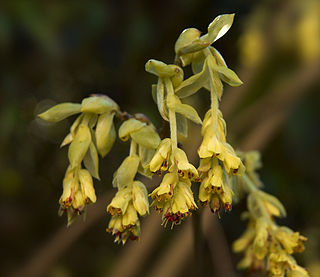
Corylopsis pauciflora, the buttercup witch hazel or winter hazel, is a species of flowering plant in the family Hamamelidaceae, native to Taiwan and Japan. It is a deciduous, spreading shrub growing to 1.5 m tall by 2.5 m wide. It produces masses of pale yellow flowers in pendent racemes in early spring, followed by leaves opening bronze and turning to rich green. It is cultivated in gardens and parks in temperate regions.

Berberis bealei, also known as leatherleaf mahonia, Beale's barberry, is a species of evergreen shrub native to mainland China. The species has been regarded as the same species as Berberis japonica, native to Taiwan, but the two differ consistently in certain floral and leaf characters. Both species are widely cultivated in many countries as ornamentals. Berberis bealei has reportedly escaped cultivation and become established in the wild in scattered places in the south-eastern United States from Arkansas to Florida to Delaware.

Corylopsis sinensis, the Chinese winter hazel, is a species of flowering plant in the witch-hazel family Hamamelidaceae, native to western China. Growing to 4 m (13 ft) tall and broad, it is a substantial deciduous shrub. With ovate leaves, it produces delicately fragrant, drooping racemes of pale yellow flowers with orange anthers in spring.
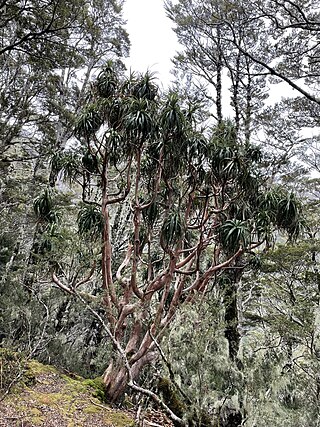
Dracophyllum traversii, commonly known as mountain neinei, grass tree, and pineapple tree is a species of flowering plant in the heath family Ericaceae. It is a deciduous tree endemic to New Zealand. It reaches a height of 0.2–13 m (0.66–42.65 ft) and has leaves which form tufts at the end of its branches. It has a lifespan of between 500 and 600 years.























